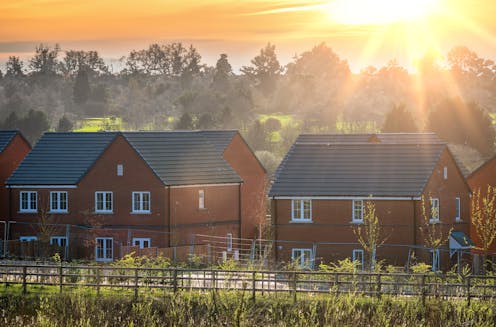Tackling the UK’s housing crisis means addressing one key problem: affordability
- Written by Paul Anand, Professor of Economics, The Open University

The UK government has serious ambition when it comes to solving England’s housing crisis. Shortly after the 2024 general election, it pledged to build 1.5 million[1] new homes over the next five years.
It’s a big plan which could help improve the quality of life[2] of millions of people. But is such an ambitious target[3] plausible? Or has the government created a rod for its own back, and embarked on an economic mission that is doomed to failure?
For, at the heart of this mission is a political desire to shape the direction of the economy. And to succeed, this desire needs to be matched with a clear understanding of the economic reality at the heart of the UK’s housing crisis – a reality that is all about affordability[4].
To be successful, housing policies aimed at helping those on lower incomes need to address this[5] head on. But the government’s emphasis[6] so far has been on “zoning” (allowing houses to be built on land which was previously protected), or speeding up the planning process and tackling nimbyism. All of these factors are distractions from the main and simple point – that too many people simply cannot afford to buy, or even rent, a decent home.
And while there has been some suggestion that a bigger proportion of new housing projects need to be affordable, details have been scant.
Instead, most of the talk has been about “greybelt zones”, where planning permission will be granted more easily and quickly to create new opportunities for house building. But it is far from clear this will help to bring down – or even stabilise – the costs of housing.
Obtaining planning permission is a small fraction of that total cost. And when these permissions are granted, the value of land rises. The landowner makes money, but the hopeful future house buyer or tenant gains nothing, other than the fact there are extra houses on the market.
Imposing a requirement for higher proportions of affordable housing from building companies might be the single most effective thing the government can do. However, those companies may then increase their margins on the larger houses they plan to sell. And higher prices for bigger homes raises demand – and then prices – for smaller ones.
If the government wants to tackle the affordability issue by increasing supply, it should note that just over half the costs[7] of new housing are down to expensive construction. The use of modern pre-fabricated methods[8] to help reduce those costs is still relatively low in the UK.
Sweden uses this approach for over 80%[9] of its new house building, and a faster switch (with government persuasion) to more affordable building methods in the UK could be beneficial.
More new towns have also been promised. They’re not a bad idea, but building them takes a very long time[11], so any contribution they make to the housing crisis will take years (decades even) to be seen.
The government has already announced a series of house-building targets for local areas[12] as part of its five-year plan. But this adds a further complication, in a classic example of regional planning being done from Westminster instead of locally. How do they know that these houses will be built where people actually want to live?
For a good sense of where people do want to live, the government could immediately turn to housing associations – private, non-profit making organisations that already provide low-cost housing to millions[13]. There might be some mileage in seeking to boost their stock by encouraging – and even underwriting – further borrowing by them.
Typically, housing associations charge significantly lower rents[14] as they are not focused on making a return for shareholders, and their long-term stability attracts lower borrowing costs. If the government’s promised increase in the UK’s housing stock leads to an expansion in the housing association sector, this could make a meaningful contribution to limiting the rents paid by those on lower incomes – and enhancing the potential for them to eventually buy a genuinely affordable home.
But for many others, the biggest hurdle over the coming years will be mortgage rates[15]. Even if interest rates come down gradually over the next five years, this is unlikely to make much difference to those who cannot afford a mortgage. And it won’t happen quickly enough to conjure up 1.5 million new homeowners in five years.
It seems doubtful then, that the government will reach its target, however laudible. But if it is to stand a chance, it needs to be thoughtful in its economics. Merely setting targets and expressing frustration when they are not met – as they are unlikely to be – is not enough.
References
- ^ build 1.5 million (www.housing.org.uk)
- ^ quality of life (ideas.repec.org)
- ^ ambitious target (theconversation.com)
- ^ about affordability (link.springer.com)
- ^ need to address this (www.tandfonline.com)
- ^ government’s emphasis (bmmagazine.co.uk)
- ^ half the costs (www.housingtoday.co.uk)
- ^ pre-fabricated methods (theconversation.com)
- ^ over 80% (www.forbes.com)
- ^ Clare Louise Jackson/Shutterstock (www.shutterstock.com)
- ^ very long time (theconversation.com)
- ^ targets for local areas (www.mirror.co.uk)
- ^ to millions (www.housing.org.uk)
- ^ significantly lower rents (link.springer.com)
- ^ mortgage rates (academic.oup.com)







